2020年整理四升五英语复习模拟卷.doc
四升五英语复习模拟卷(2020年7月整理).pdf

一、知识点回顾1、like+v-ingeg: I like running.2、一般疑问句“用什么问,用什么答”eg: Do you like running? Yes, I do. \ No I don’t.eg: Is your mother a teacher? Yes, she is.\ No, she isn’t.3、问有多少:how many+可数名词复数,how much+ 不可数名词a lot of =lots of “许多、大量”后接可数名词复数或不可数名词表示“有”:have→某人有某物,前面一定有主语there be→某地有某物,一般置于句首there be 中的be要根据表示有的人或物的单复数去确定,如句中有多种东西并列,be的数跟最近的人或物的数保持一致(就近原则)。
eg: I have a pen.主语,表示某人There is a pen and two books on the desk.4、let’s=let us 后接动词原形B、“他”,第三人称单数,确定用does7、一般现在时:一般现在时 的陈述句改否定句和一般疑问句①句中有be 动词: 否定句直接在be 后加not ;一般疑问句把be 提前,I 变you ,am 变are, 末尾用问号。
eg: 一般疑问句→ Are you a student?否定句→I am not a student.一般疑问句→ Is she a nurse?否定句→ She is not a nurse.②句中有行为动词(有实在意义的动词),借助助动词do 或does 来完成否定句和一般疑问句。
eg: He likes swimming.否定句:助动词置于行为动词前,否定要用not 行为动词的数表现在助动词上,a 、“喜欢”,行为动词,借助do 或does所以助动词后面用动词原形。
否定句 why 、eg : What does he like?8、现在进行时1. 表示现在这个时刻正在发生的动作,标志性时间为:now 、this moment 、 this second 等表示现在时刻的时间状语;或者句中出现:listen 、look 此类隐含现在时刻的动作;或句中出现包括现在时刻的一段时间如:these days 、these weeks 、these months 、this years3. 以重读闭音节结尾的,双写末尾辅音字母再加ing ,如:run -running ,stop -stopping ,swim -swimming ,cut -cutting ,eg:I am preparing a project these years. 变否定句直接在be 后加notnow变否定句直接在be后加notfuture将来的时间,用一般将来时Or前or后,and前and后,词性一致910、“或者”or用于否定句或者一般疑问句中表示选择and用于肯定句11、冠词a、an的用法表示“一个”,an用在发元音音素的字母前面,一般是a、e、i、o、u,其他用a(可总结为:不见元音不施恩an)12、连词成句的解题思路:先看符号确定句子是陈述句还是问句,①句号——陈述句:先找主语,再找谓语,根据词语搭配,完成句子。
2020年整理四升五英语测试题.doc
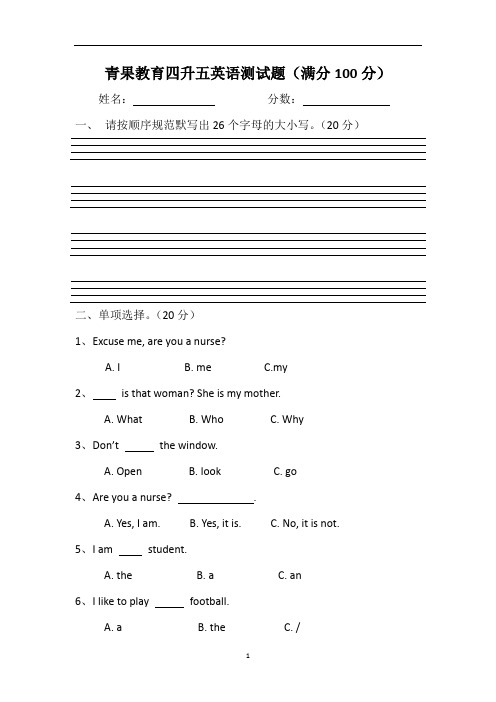
青果教育四升五英语测试题(满分100分)姓名:分数:一、请按顺序规范默写出26个字母的大小写。
(20分)二、单项选择。
(20分)1、Excuse me, are you a nurse?A. IB. meC.my2、is that woman? She is my mother.A. WhatB. WhoC. Why3、Don’t the window.A. OpenB. lookC. go4、Are you a nurse? .A. Yes, I am.B. Yes, it is.C. No, it is not.5、I am student.A. theB. aC. an6、I like to play football.A. aB. theC. /7、I go to school by .A. a bikeB. busC. foot8、What color do you like best? .A. How are you?B. Green.C. My mother.9、What do you do at school? .A. It’s on the table.B. I’m a pupil.C. Learning English.10、What animals has Bill got? .A. Cats.B. He is reading a book.C. He is short.三、选出合适的单词填入相应的类别中。
(15分)brother eye pen yellow lemon1、book pencil ruler2、father mother sister3、apple pear banana4、nose arm leg5、red green black四、单词连线。
(20分)horse 床鱼carrotbasketball 大象班级classbed 马起床fishelephant 窗户胡萝卜gardenwindow 棒球花园get up五、情景交际。
四升五英语复习模拟卷.doc
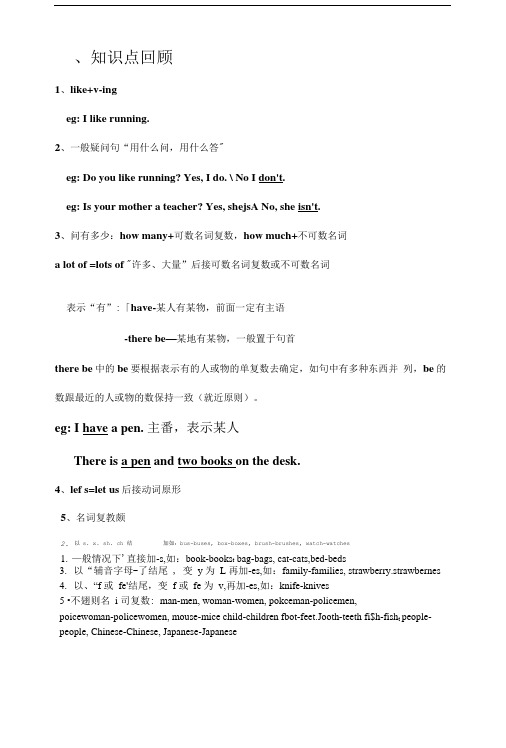
、知识点回顾1、like+v-ingeg: I like running.2、一般疑问句“用什么问,用什么答"eg: Do you like running? Yes, I do. \ No I don't.eg: Is your mother a teacher? Yes, shejsA No, she isn't.3、问有多少:how many+可数名词复数,how much+不可数名词a lot of =lots of "许多、大量”后接可数名词复数或不可数名词表示“有”:「have-某人有某物,前面一定有主语-there be—某地有某物,一般置于句首there be中的be要根据表示有的人或物的单复数去确定,如句中有多种东西并列,be的数跟最近的人或物的数保持一致(就近原则)。
eg: I have a pen. 主番,表示某人There is a pen and two books on the desk.4、lef s=let us后接动词原形5、名词复教颇2.以s. x. sh. ch 结加如:bus-buses, box-boxes, brush-brushes, watch-watches1.—般情况下'直接加-s,如:book-books t bag-bags, cat-cats,bed-beds3.以“辅音字母-了结尾 , 变y 为L 再加-es,如:family-families, strawberry.strawbernes4.以、“f 或fe'结尾,变f 或fe 为v,再加-es,如:knife-knives5 •不翅则名i 司复数: man-men, woman-women, pokceman-policemen,poicewoman-policewomen, mouse-mice child-children fbot-feet.Jooth-teeth fi$h-fish t people-people, Chinese-Chinese, Japanese-Japanese6,动词E单蹒t艰则1.—般情况下,直接加・s> 如:cook-cooks, miik-milks2.以s. x. sh. ch. o 结尾 > Jo-es,女口: guess-guesses, wash・washes, watch-watches, go-goes3.以' 辅音字母结尾'变y为i,再加・es,如:study-studies7、一般现在时:一般现在时的功能1 .表示事物或人物的特征、状态。
人教PEP版四升五英语摸底测试卷2套(附听力答案)
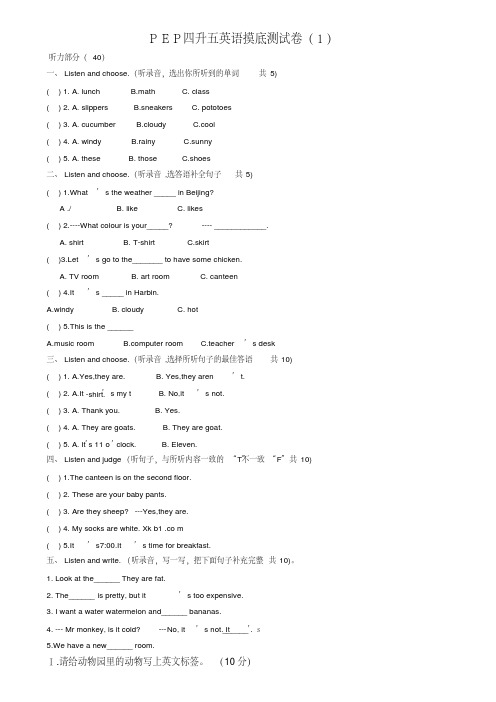
PEP四升五英语摸底测试卷(1)听力部分(40)一、Listen and choose.(听录音,选出你所听到的单词共5)( ) 1. A. lunch B.math C. class( ) 2. A. slippers B.sneakers C. pototoes( ) 3. A. cucumber B.cloudy C.cool( ) 4. A. windy B.rainy C.sunny( ) 5. A. these B. those C.shoes二、Listen and choose.(听录音,选答语补全句子共5)( ) 1.What’s the weather _____ in Beijing?A ./ B. like C. likes( ) 2.----What colour is your_____? ---- ____________.A. shirtB. T-shirtC.skirt( )3.Let’s go to the_______ to have some chicken.A. TV roomB. art roomC. canteen( ) 4.It’s _____ in Harbin.A.windyB. cloudyC. hot( ) 5.This is the ______A.music roomputer roomC.teacher’s desk三、Listen and choose.(听录音,选择所听句子的最佳答语共10)( ) 1. A.Yes,they are. B. Yes,they aren’t.( ) 2. A.It’s my t-shirt. B. No,it’s not.( ) 3. A. Thank you. B. Yes.( ) 4. A. They are goats. B. They are goat.( ) 5. A. It’s 11 o’clock. B. Eleven.四、Listen and judge(听句子,与所听内容一致的“T”不一致“F”共10)( ) 1.The canteen is on the second floor.( ) 2. These are your baby pants.( ) 3. Are they sheep? ---Yes,they are.( ) 4. My socks are white. Xk b1 .co m( ) 5.It’s7:00.It’s time for breakfast.五、Listen and write.(听录音,写一写,把下面句子补充完整共10)。
4升5衔接检测卷-英语五年级上册人教PEP版(含答案)
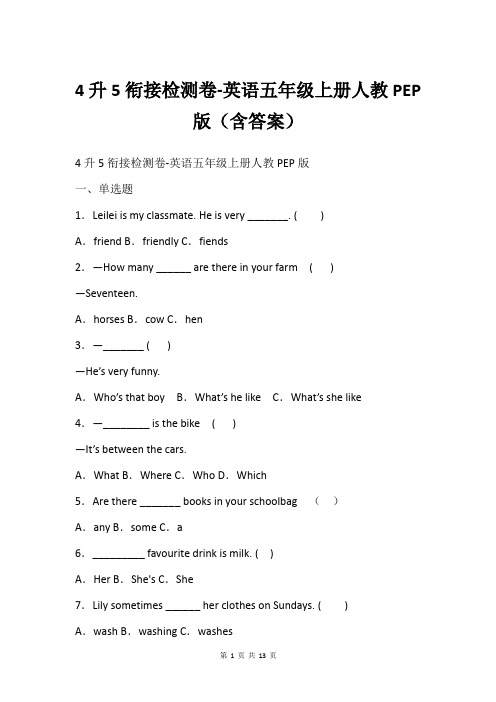
4升5衔接检测卷-英语五年级上册人教PEP版(含答案)4升5衔接检测卷-英语五年级上册人教PEP版一、单选题1.Leilei is my classmate. He is very _______. ( )A.friend B.friendly C.fiends2.—How many ______ are there in your farm ( )—Seventeen.A.horses B.cow C.hen3.—_______ ( )—He’s very funny.A.Who’s that boy B.What’s he like C.What’s she like4.—________ is the bike ( )—It’s between the cars.A.What B.Where C.Who D.Which5.Are there _______ books in your schoolbag ()A.any B.some C.a6._________ favourite drink is milk. ( )A.Her B.She's C.She7.Lily sometimes ______ her clothes on Sundays. ( )A.wash B.washing C.washes8.( ) I study _____ Sunny School .A.in B.at C.on9.Is there a river ______ the mountain. ( )A.in front B.in front of C.front of D.front二、用单词正确形式填空10.(Who) shoes are these11.There (be) a river in the forest.12.Usually we have some (tomato) and bread for lunch on Tuesday.13.I’d like a (sandwich).三、词形转换14.young (反义词)15.说英语(汉译英)16.can not (缩写形式)17.美味的(汉译英)18.know (同音词)四、句子匹配19.从Ⅱ栏中选出Ⅱ栏句子对应的答语。
4升5预习检测卷-英语五年级上册外研版(三起)(含答案)

4升5预习检测卷-英语五年级上册外研版(三起)(含答案)4升5预习检测卷-英语五年级上册外研版(三起)学校:___________姓名:___________班级:___________考号:___________一、单选题1.—______ chocolate did she buy ( )—She bought half a kilo.A.How much B.How many C.What2._______ juice do you want ( )A.How much B.How C.How many3.Daming _______ a photo of his father yesterday. ()A.took B.take C.taking4.Today is Thursday and yesterday was _____. ( )A.Tuesday B.Wednesday C.Friday5.He didn’t __________ Mum yesterday. ()A.help B.helped C.helps6.—Sam is ill in hospital. ( )—________A.I'm so sorry to hear that. B.Here you are. C.That's Okay. 7.There __________ some orange juice in the bottle. ( )A.are B.is C.have二、补全句子8.She a goes to school by bike.9.Can you pass the ball w10.—Look! What’s (那) —It’s a toy car.三、中英文匹配A.它将会做家务。
B.机器人将会做所有的事情。
C.机器人将会做蛋糕。
D.萨姆会放风筝。
E. 机器人会走路。
【四升五】 四下英语复习Unit 5--6(梳理+基础卷+提高卷)(含答案)人教pep

名校暑假培优人教PEP四升五复习四下Unit 5—6知识梳理第五单元My clothes一、语音-le[l]:(舌头翘起,发类似“奥”的音)apple、people、table、little、noodle、vegetable(蔬菜)、circle(圈)二、词汇clothes 衣服pants 裤子hat 帽子dress 连衣裙skirt 短裙coat 外套sweater 毛衣sock袜子shorts短裤jacket夹克衫shirt 衬衫yours 你的whose谁的mine我的pack收拾wait等待party派对cut 剪something一些东西draw 画star明星put on穿上hang up挂起来wash 洗put away 放好take off脱下三、知识点1、对应词:put on(穿上) -- take off (脱下)white—black these--those2、特殊疑问词What colour 什么颜色用来问物体的颜色,回答时一定要有表示颜色的词语。
如:What colour is your bag It’s blue.3、Who 和Whose的区别:Who谁。
用来问人是谁。
如:Who is that girl?那个女孩是谁?She is my sister.她是我的姐妹。
Who is that tall man?那个高个子男人是谁?He is my father.他是我的爸爸。
Whose 谁的。
用来询问物品是谁的。
在回答Whose引领的问题时,如果答案有人名,要在人名的后面加‘s, 其中的’s表示“某人的”。
如:Whose shirtis this?这是谁的衬衣?It’s Mike’s .它是Mike的。
Whose bike is blue?谁的书包是蓝色的? My bag is blue.我的书包是蓝色的。
4、have(第三人称单数)――has (he/she/it 后面用has , I/we/you/they 后面用have)5、pants , socks , shoes , shorts , jeans 这些单词都是成双成对出现的,所以在句子中一般都是复数形式。
4升5预习检测卷-英语五年级上册人教PEP版(含答案)
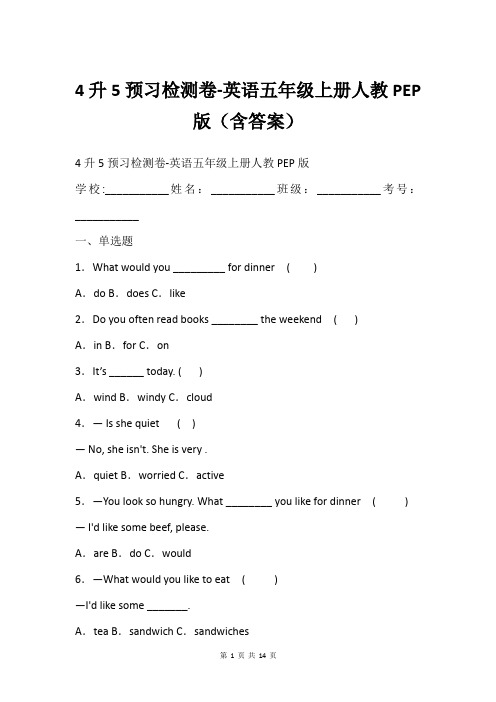
4升5预习检测卷-英语五年级上册人教PEP版(含答案)4升5预习检测卷-英语五年级上册人教PEP版学校:___________姓名:___________班级:___________考号:___________一、单选题1.What would you _________ for dinner ( )A.do B.does C.like2.Do you often read books ________ the weekend ( )A.in B.for C.on3.It’s ______ today. ( )A.wind B.windy C.cloud4.— Is she quiet ( )— No, she isn't. She is very .A.quiet B.worried C.active5.—You look so hungry. What ________ you like for dinner ( )— I'd like some beef, please.A.are B.do C.would6.—What would you like to eat ( )—I'd like some _______.A.tea B.sandwich C.sandwiches7.The library is _____ the teachers’ office. ( )A.next B.next to8.He’s __________________ an e-mail. ( )A.writing B.write C.written9.Let's __________ the music room. ( )A.to B.to go C.go to二、补全句子10.There is a clock a the desk.11.I’d like some (三明治). They are (美味的). 12.—What’s he like —He is (有礼貌的).13.Its weather is (凉爽的) in fall.14.I can (打乒乓球), but I can’t (练武术).三、选词/短语填空15.I’m (hungry / thirsty). I’d like some noodles.16.What would (your/you)like17.I can play (the / \) erhu for the party.四、句图匹配A.B.C.D.E.18.The ball is above the dog. ( )19.They are helpful. They can clean the classroom. ( ) 20.—What’s he like ( )—He’s polite.21.There is a bottle on the table. ( )22.Robin can sing English songs. ( )五、句子匹配A.She’s kind. B.Thank you! C.Fish. D.No, I don’t. E. Yes, I can. 23.Can you cook ( )24.What’s your favourite food ( )25.What’s Chen Jie like ( )26.Do you often sing songs ( )27.I can help you! ( )六、中英文匹配A.说英语B.辛勤的C.洗衣服D.踢足球E. 去划船28.hard-working ( )29.speak English ( )30.play football ( )31.wash my clothes ( )32.go boating ( )七、排序题33.把下面的句子重新排序组成一段完整的对话。
英语统考模拟试卷11(四升五)

英语统考模拟试卷11(四升五)英语统考模拟试卷11(四升五)试卷100分,时间70分命题:刘慧颖1 . 听一听40分一、根据所听内容,选择正确的答句。
10分(听两遍)1.( ) A. B.2.( ) A. B.3.( ) A. B.4.( ) A. B.5.( ) A. B.二、根据所听内容,选择正确的应答。
10分(听两遍)( )1.A .Yes,I can. B. Yes,I am. ( )2.A.Let’s play. B.Take this pill. ( )3.A.At six. B.At eleven twenty. ( )4.A.What a pity. B.Good idea. ( )5. A. It’s three. B.Three.三、根据听到的内容,选择正确答案。
10分(听两遍)()1. We usually go boating in______.A.SummerB.autumnC. spring( )2 .Mr Green is ________.A.at homeB.at schoolC. in the park( ) 3. The ______ are Anne’s.A.jeansB. glovesC. shorts( ) 4. Paul is ______.A.thirstyB. hungryC. happy( )5. Jack can _______.A.play footballB. fly kitesC. go swimming四、根据所听内容在图片中标出相对应的位置。
10分(听三遍)( 1 )( 2 )( 3 )( 4 ) ( 5 )读一读(50分)1)阅读,根据对话内容在方框内选择合适的句子,并将其序号填在横线上。
10 分A.WhoseB. inC. lessons1.Su Hai has a swimming lessonthe afternoon.2.---trousers are these,Mike?---They're Tom's.3. It's hot in summer in Nanjing. I .4. It’s time for PE. Let's go to the .5.What do you have in the morning? 2)阅读理解(40分)1、阅读对话,根据语境选择正确的图片(10分)( A ) ( B)( C )( D ) (E )1.--What are those over there?--They’re .--Let’s go there and have a look.2.--What day is it today?--It’s .--What time is it?--It’s o’clock.It’s time for a swimming lesson.3.It’s five . I t’s time to .4.--What subjects do you like?--I like and Art .2、非连续性文本My Day14:00 get up15:20 have dinner16:00 go to work(上班)24:00 go home2:00 go to bed阅读表格,判断正(T)误(F)。
【四升五】 人教PEP 四下英语复习Unit 3--4(梳理+基础卷+提高卷)(含答案)
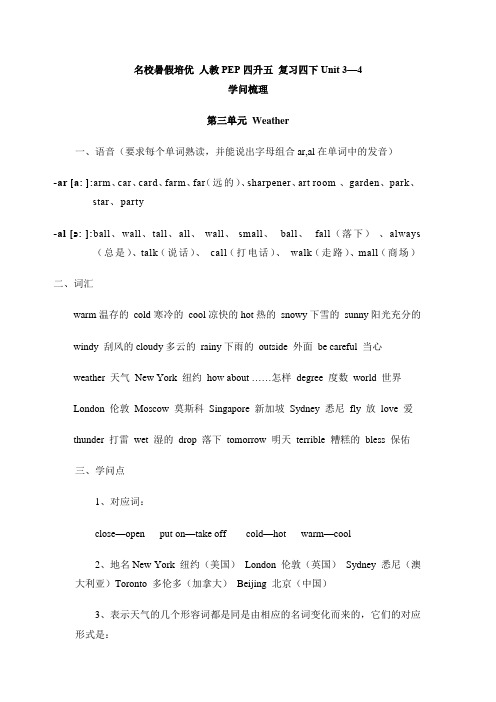
名校暑假培优人教PEP四升五复习四下Unit 3—4学问梳理第三单元Weather一、语音(要求每个单词熟读,并能说出字母组合ar,al在单词中的发音)-ar [a: ]:arm、car、card、farm、far(远的)、sharpener、art room、garden、park、star、party-al [כ: ]:ball、wall、tall、all、wall、small、ball、fall(落下)、always (总是)、talk(说话)、call(打电话)、walk(走路)、mall(商场)二、词汇warm温存的 cold寒冷的 cool 凉快的 hot热的snowy下雪的 sunny阳光充分的windy 刮风的cloudy多云的rainy下雨的outside 外面be careful 当心weather 天气New York 纽约how about ……怎样degree 度数world 世界London 伦敦Moscow 莫斯科Singapore 新加坡Sydney 悉尼fly 放love 爱thunder 打雷wet 湿的drop 落下tomorrow 明天terrible 糟糕的bless 保佑三、学问点1、对应词:close—open put on—take off cold—hot warm—cool2、地名New York 纽约(美国)London 伦敦(英国)Sydney 悉尼(澳大利亚)Toronto 多伦多(加拿大)Beijing 北京(中国)3、表示天气的几个形容词都是同是由相应的名词变化而来的,它们的对应形式是:名词形式形容词形式rain 雨rainy 下雨的snow雪snowy下雪的wind 风windy 有风的cloud 云cloudy 有云的sun阳光sunny晴朗的4、一般疑问句Can you…的回答形式有两种,确定回答是:Yes, I can. 否定回答是: No, I can’t.一般疑问句Can I … 的回答形式也有两种,确定回答是:Yes, you can. 否定回答是: No, you can’t. 而Can I help you 一般不说Yes,you can. 一般回答Yes, please./No, thanks.5、同义词:How about … ===What about …怎么样6、当问某个地方的天气如何时,要用What’s the weather like in +地名如:What’s the weather like in Beijing北京的天气怎么样必背句型:①What are you doing你正在干什么呀②What's the weather like in Beijing 北京天气如何What's the weather like + 地方③What's the matter, Amy 艾米,怎么了What's the matter 怎么了(询问状况)④I have to close the window. 我必需关上窗子。
四升五英语试卷文档
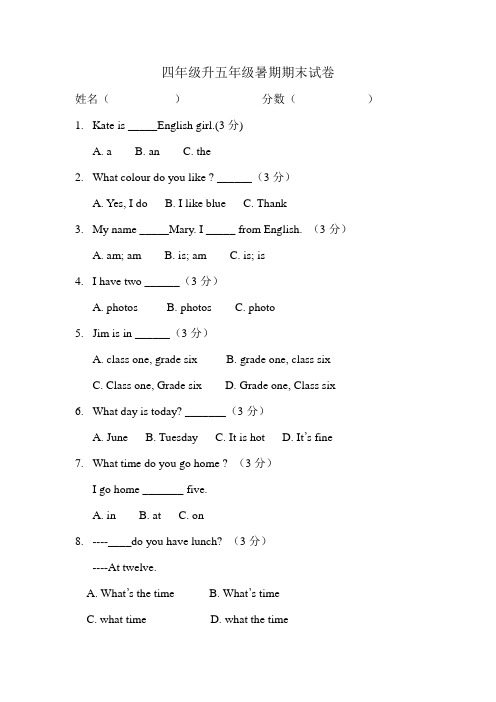
四年级升五年级暑期期末试卷姓名()分数()1.Kate is _____English girl.(3分)A. aB. anC. the2.What colour do you like ? ______(3分)A. Yes, I doB. I like blueC. Thank3.My name _____Mary. I _____ from English. (3分)A. am; amB. is; amC. is; is4.I have two ______(3分)A. photosB. photosC. photo5.Jim is in ______(3分)A. class one, grade sixB. grade one, class sixC. Class one, Grade sixD. Grade one, Class six6.What day is today? _______(3分)A. JuneB. TuesdayC. It is hotD. It’s fine7.What time do you go home ? (3分)I go home _______ five.A. inB. atC. on8.----____do you have lunch? (3分)----At twelve.A. What’s the timeB. What’s timeC. what timeD. what the time9. Is she your grandmother? (3分)A. No, he isn’tB. Yes, he isC. No, she isD. No, she is10.---____your sister? (3分)----She is Seven.A. How oldB. HowC. What二.阅读短文,选择正确答案。
I’m a student. My name is Tom. I’m nice. I’m in class One, Grande Four. Li lei is my classmates(同学). He is ten. We’re from Nanjing.1. How old is Tom?(5分)He’s _____.A. 11B.10C.92. Is Li Lei in____? ----Yes, he is. (5分)A.Class4, Grade1B. Class2, Grade4C. Grade4,Class13. Li Lei and Tom are____.(5分)A. boyB. girlsC. Classmates4. Li Lei is____.(5分)A. elevenB. tenC. Ten5. Tom is from____.(5分)A. ShanghaiB. USAC. Nanjing三.连词成句,注意标点符号和大小写。
人教PEP版英语四升五摸底测试卷2套附听力答案

cow gloves cap sheep goat skirt shirt horse hen pants
animals: _________________________________________________________ clothes: __________________________________________________________ 八、单项选择。 (10 分)
( )3.Can John swim?
A. Yes, he can.
B. No, he can't.
( )4.What is John wearing?
A. Trousers.
B. A shirt.
C. A T- shirt and shorts.
( )5.How many new friends does John have?
人教PEP版英语四升五摸底测试卷(一)
(时间: 60 分
总分: 100 分)
听力部分 (40 分)
一、听录音 , 选择你听到的单词。 (5 分)
( )1.A.first
B. second
( )2.A.art
B. music
( )3.A.breakfast
B. lunch
( )4.A.school
B. cool
C. tomatoes
( )8.Can I try the gloves________?
A. on
B. off
C. in
( )9.—Can I go outside?—________
A. Sure.
B. Let me help you. C. I can help you.
英语统考模拟题12(四升五)
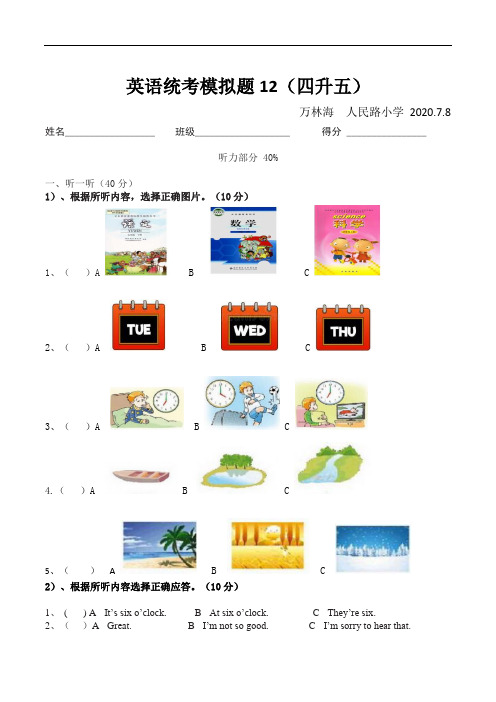
英语统考模拟题12(四升五)万林海人民路小学2020.7.8 姓名__________________ 班级___________________得分 ________________听力部分 40%一、听一听(40分)1)、根据所听内容,选择正确图片。
(10分)1、()A B C2、()A B C3、()A B C4.()A B C5、() A B C2)、根据所听内容选择正确应答。
(10分)1、( ) A It’s six o’clock. B At six o’clock. C They’re six.2、()A Great. B I’m not so good. C I’m sorry to hear that.3、()A It’s Helen’s. B They’re Helen’s. C They’re Helen.4、( ) A Yes,please. B No,thanks. C Have some cakes.5、( ) A I’m ill. B I’m fine. C Not so good.3)、根据听到的内容,选择正确的答案。
(10分)1、( ) A watch TV. B do her homework. C swim.2、( ) A Yes,she can. B Yes,I can. C She can see a tree.3、( ) A Spring. B Summer. C Autumn.4、( ) A She has a cold. B She has a fever. C She has a headache5、( ) A Yes,she is. B No,she isn’t. C She’s tired.4)、根据所听内容,在图片中标出相对应的位置。
(10分)A sweaterB trousersC dressD shortsE gloves笔试部分 60%二、读一读(50分)1)、选词完成对话。
小学英语四升五试题及答案

小学英语四升五试题及答案一、选择题(每题2分,共20分)1. What's this in English?A. 这是一个苹果。
B. This is an apple.C. An apple is this.D. Apple this is.2. How many days are there in a week?A. 7B. 6C. 5D. 83. What color is the sky?A. BlueB. RedC. GreenD. Yellow4. What do you do on weekends?A. I go to school.B. I go to the park.C. I stay at home.D. I work.5. How old are you?A. I'm 10 years old.B. I'm 20 years old.C. I'm 30 years old.D. I'm 40 years old.6. What's your favorite food?A. PizzaB. HamburgerC. SaladD. Sushi7. Where is the library?A. Next to the school.B. Next to the park.C. Next to the hospital.D. Next to the supermarket.8. What time do you get up in the morning?A. At 6 o'clock.B. At 7 o'clock.C. At 8 o'clock.D. At 9 o'clock.9. What does your mother do?A. She is a teacher.B. She is a doctor.C. She is a nurse.D. She is a lawyer.10. How do you go to school?A. By bus.B. By car.C. By bike.D. On foot.二、填空题(每题2分,共20分)1. My name is _______. (我的名字是小明。
4升5预习检测卷-英语五年级上册译林版(三起)(含答案)
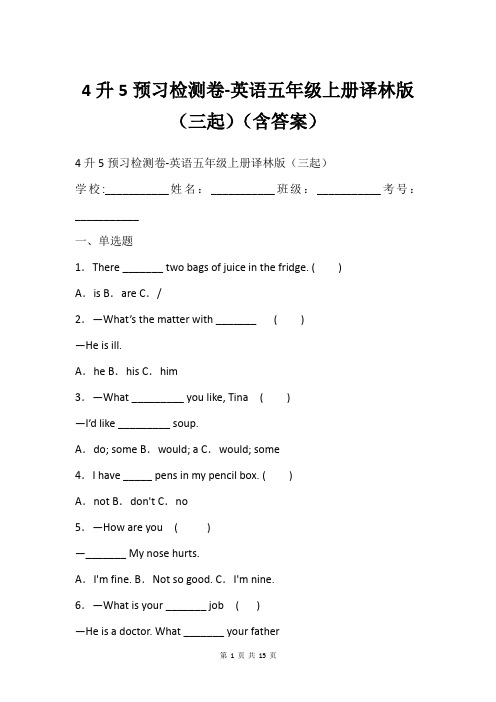
4升5预习检测卷-英语五年级上册译林版(三起)(含答案)4升5预习检测卷-英语五年级上册译林版(三起)学校:___________姓名:___________班级:___________考号:___________一、单选题1.There _______ two bags of juice in the fridge. ( )A.is B.are C./2.—What’s the matter with _______ ( )—He is ill.A.he B.his C.him3.—What _________ you like, Tina ( )—I’d like _________ soup.A.do; some B.would; a C.would; some4.I have _____ pens in my pencil box. ( )A.not B.don't C.no5.—How are you ( )—_______ My nose hurts.A.I'm fine. B.Not so good. C.I'm nine.6.—What is your _______ job ( )—He is a doctor. What _______ your fatherA.father; about B.father’s; about C.father’s; for D.father; for 7.—_________ do you have breakfast ( )—I have breakfast _________ seven.A.When; at B.What; at C.What time; is8.A: ________ are the presents ( )B: They're under the tree.A.What B.What colour C.Where9.( )Helen _____ well and she likes _____very much. A.skates,skating B.skating,skates C.skate,skating二、补全句子10.Let’s d some pictures here.11.Her classroom is on the (第三层楼).12.Mr Green (通常) has aa basketball match on Sunday . (下午)13.Mary is a good girl. She always gets (第一) in her class. 14.Mike is (生病而且累了). He wants to sleep.三、选词/短语填空15.Here (are / is) some juice for you.16.People eat (a turkey / turkeys) at Christmas.17.The polor bears are from ( the US / Canada).18.—Let’s go to (home / school) together.—Great!19.—Hurry up! It’s time (to / for) school.—We don’t have (some / any) lessons today.四、句图匹配图文匹配。
四升五英语考试题及答案
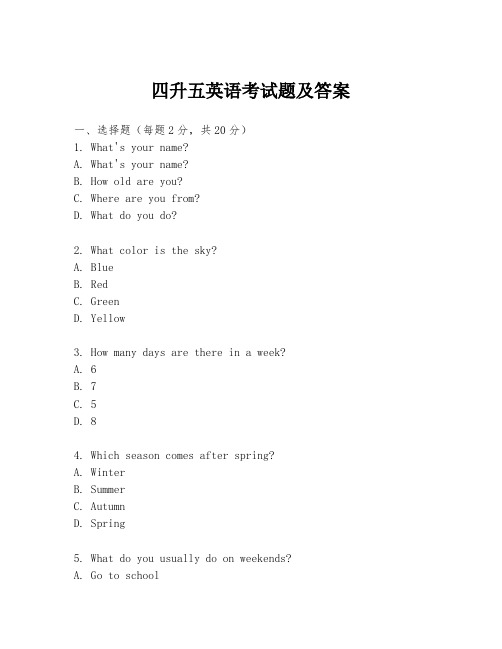
四升五英语考试题及答案一、选择题(每题2分,共20分)1. What's your name?A. What's your name?B. How old are you?C. Where are you from?D. What do you do?2. What color is the sky?A. BlueB. RedC. GreenD. Yellow3. How many days are there in a week?A. 6B. 7C. 5D. 84. Which season comes after spring?A. WinterB. SummerC. AutumnD. Spring5. What do you usually do on weekends?A. Go to schoolB. Do homeworkC. Watch TVD. Play sports6. What is the capital of China?A. ShanghaiB. BeijingC. GuangzhouD. Shenzhen7. How do you go to school every day?A. By busB. By carC. On footD. By bike8. What is your favorite subject?A. MathB. EnglishC. ScienceD. Art9. When is your birthday?A. January 1stB. July 4thC. October 1stD. December 25th10. Where do you live?A. In a houseB. In a flatC. In a hotelD. In a tent二、填空题(每题2分,共20分)11. My favorite fruit is _______. (苹果)12. I can play _______. (钢琴)13. The weather is _______ today. (晴朗)14. We have four _______ in a year. (季节)15. My mother is a _______. (医生)16. I usually get up at _______ in the morning. (7点)17. There are _______ days in February. (28)18. The _______ is very tall. (长城)19. I like to eat _______ for breakfast. (面包)20. We celebrate _______ on October 1st. (国庆节)三、阅读理解(每题2分,共20分)阅读下面的短文,然后回答问题。
四升五英语开学模拟测试卷(4)(译林版三起含答案)

开学模拟测试卷(4)一、选出每组中不同类的一项( ) 1. A. summer B. spring C. Sunday( ) 2. A. season B. shirt C. skirt( ) 3. A. fever B. cough C. care( ) 4. A. jeans B. sweater C. shorts( ) 5. A. hot B. cool C. weather二、按要求完成下列各题1. class(复数形式)________2. she(形容词性物主代词)________3. Bobby(名词所有格)________4. do not(缩写形式)________5. flower(复数形式)________6. skate(动名词形式)________7. these(单数形式)________ 8. go(反义词)________9. aren’t(完整形式)________ 10. hear(同音词)________三、英汉互译1. 一节数学课__________________2. 保重__________________3. 星期三晚上__________________4. 看电视________________5. 在七点三十分去上学__________6. 三门学科______________7. every season__________________ 8. Welcome to my school!____________ 9. The ball can move._____________ 10. It’四、单项选择( ) 1. Look at Helen. Her hat________so small and her shoes________so big.A. are, isB. is, areC. is, is( ) 2. Joe________dance, but I can.A. canB. likesC. can’t( ) 3. I have breakfast________six fifty________the morning.A. at, onB. on, inC. at, in( ) 4. -________that tall man?-He’s my uncle.A. Who’sB. WhoseC. Who( ) 5. I want________some milk.A. drinkB. to drinkC. drinking( ) 6. It’s Saturday. We don’t have________lessons today.A. someB. anyC. a( ) 7. Helen is not at school today. What’s the matter with________?A. sheB. himC. her( ) 8. -I feel________.-Here are some cakes for you.A. hungryB. coolC. ill( ) 9. Summer is________. We can________.A. hot, eat ice creamsB. cold, go skatingC. warm, have picnics ( ) 10. -May I speak to Miss Fox?-Yes. ________A. I’m Miss Fox.B. This is Miss Fox speaking.C. Yes, I am.五、用所给单词的适当形式填空1. -How________(be) you?-I________(be) fine, thank you.2. It’s hot today. Let’s go________(swim).3. Mary can________(make) a fruit salad.4. Those________(woman) are on the farm.5. How many________(bird) can you see in the tree?6. -Whose trousers are they?-They’re my________(sister).7. It’s time________(have) PE.8. What________(lesson) do you have this afternoon?9. ________(who) dress is this?六、按要求完成句子1. I like English and Art.(改为一般疑问句)________ ________like English and Art?2. Mary can make a doll.(改为否定句)Mary________make a doll.3. My trousers are so beautiful.(改为否定句)My trousers________ ________so beautiful.4. I usually have breakfast at seven.(对画线部分提问) ________ ________ ________usually have breakfast?5. These socks are Yang Ling’s.(对画线部分提问)________socks are________?6. Tomorrow is Saturday.(对画线部分提问)________ ________is it tomorrow?七、根据中文提示,补全句子或对话1. -今天星期几?-星期四。
四升五英语试题
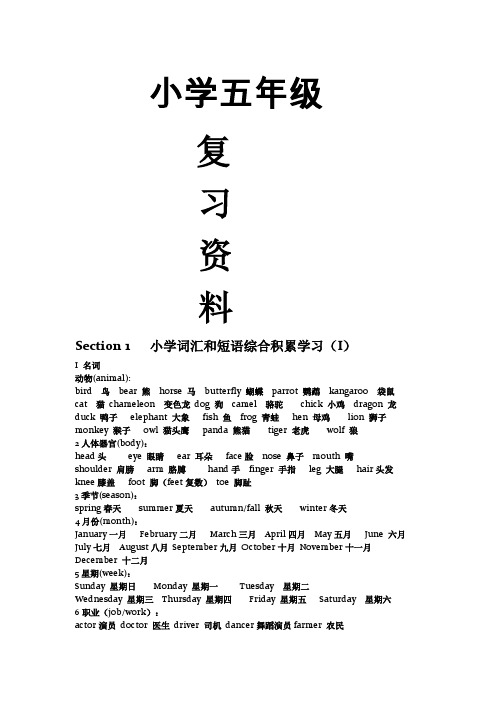
小学五年级复习资料Section 1 小学词汇和短语综合积累学习(I)I 名词动物(animal):bird 鸟bear 熊horse 马butterfly 蝴蝶parrot 鹦鹉kangaroo 袋鼠cat 猫chameleon 变色龙dog 狗camel 骆驼chick 小鸡dragon 龙duck 鸭子elephant 大象fish 鱼frog 青蛙hen 母鸡lion 狮子monkey 猴子owl 猫头鹰panda 熊猫tiger 老虎wolf 狼2人体器官(body):head头eye 眼睛ear 耳朵face脸nose 鼻子mouth 嘴shoulder 肩膀arm 胳膊hand手finger 手指leg 大腿hair头发knee膝盖foot 脚(feet复数)toe 脚趾3季节(season):spring春天summer夏天autumn/fall 秋天winter冬天4月份(month):January一月February二月March三月April四月May五月June 六月July七月August八月September九月October十月November十一月December 十二月5星期(week):Sunday 星期日Monday 星期一Tuesday 星期二Wednesday 星期三Thursday 星期四Friday 星期五Saturday 星期六6职业(job/work):actor演员doctor 医生driver 司机dancer舞蹈演员farmer 农民postman 邮递员firemen消防队员teacher 教师nurse 护士policeman警察astronaut 宇航员7家庭(family):grandparent(外)祖父(母)grandfather(外)祖父grandmother(外)祖母grandchildren(外)孙子(女)parent父(母)亲father父亲mother(mum)母亲cousin 表(堂)兄妹kid孩子brother哥(弟)sister姐(妹)son儿子uncle叔,伯,舅8国家(county):China 中国France 法国America 美国Spain 西班牙Australia 澳大利亚Canada 加拿大England 英格兰9城市(city)及处所(place):Chinatown唐人街bedroom 卧室classroom 教室farm农场field 田地flat 公寓house家,房子station 车站supermarket 超市library图书馆school 学校office办公室park 公园playground 操场,运动场restaurant 饭店, 旅馆seashore海岸,海滩square 广场10水果(fruit):apple苹果banana香蕉watermelon西瓜mango芒果orange橘子pear梨11服装(clothes) :T-shirt体恤衫cap帽子coat外套hat帽子dress连衣裙,女装shoe鞋子sweater毛线衫jeans 牛仔裤12单位:kilometer千米,公里kilo千克,公斤metre米13动作(action):dancing跳舞drawing 画jumping 跳skipping跳绳swimming 游泳shopping 购物14交通工具:aero plane直升飞机bike自行车train火车bus公共汽车boat小船ship轮船car小汽车lorry卡车plane飞机taxi出租车15节日(festival):Spring Festival春节Lantern festival元宵节Christmas圣诞节Dragon Boat festival端午节Mid-Autumn Festival中秋节Flag Day国旗日16宇宙事物及天气(weather):sky 天空air 空气wind 风cloud 云sun 太阳sunshine 阳光space太空rain 雨snow 雪17学习用品:blackboard黑板book 书desk 课桌dictionary字典pen 钢笔ruler 尺子bag 书包pencil 铅笔18人物(people):boy男孩girl 女孩friend 朋友child儿童(单)children 儿童(复)lady 女士,小姐man男人(单) men 男人(复) queen 女王pupil小学生woman 女人(单)women女人(复)19球类名词(ball):basketball 篮球baseball 棒球football 足球table tennis 乒乓球20乐器名词:flute笛子guitar吉他piano钢琴trumpet小号violin小提琴zither古筝21日用品:bed 床bag 包,袋bell 铃bottle瓶子box 盒子building 建筑物basket篮子clock 钟表camera 照相机cup杯子chopsticks 筷子door 门vase花瓶doorbell 门铃light 灯pan平底锅phone 电话radio 收音机table 桌子toothbrush 牙刷knife刀chair 椅子table 桌子TV 电视机telephone 电话television 电视机fork叉22三餐:breakfast早餐lunch午餐dinner晚餐,正餐three meals 三餐23食品(food):fast food 快餐biscuit 饼干bread 面包cake 蛋糕sausage 火腿coffee 咖啡cheese奶酪cola可乐dumplings 饺子egg 鸡蛋fish and chips 鱼和薯条moon cake月饼hot dog 热狗sweets 糖果hamburger 汉堡包ice cream 冰激凌jam 果酱peanut 花生juice 果汁meat 肉milk 牛奶sandwich 三明治noodles面条soup 汤soybean milk 豆浆tea 茶toast 烤面包vegetable 蔬菜24游戏及娱乐:balloon 气球jigsaw 拼图游戏computer games 电脑游戏, joke 笑话kite 风筝morning exercise 早操popular music 流行音乐toy 玩具25疾病:cold 感冒fever 高烧headache 头痛stomachache胃痛学科: maths 数学geography 地理history 历史music 音乐PE 体育science 科学French法语English 英语Chinese 汉语Section 2小学基本语法知识汇总一Be 动词的用法:Am--was Is --was Are--were口诀:我用am, 你用are, is用在他她它,单数用is,复数全用are。
- 1、下载文档前请自行甄别文档内容的完整性,平台不提供额外的编辑、内容补充、找答案等附加服务。
- 2、"仅部分预览"的文档,不可在线预览部分如存在完整性等问题,可反馈申请退款(可完整预览的文档不适用该条件!)。
- 3、如文档侵犯您的权益,请联系客服反馈,我们会尽快为您处理(人工客服工作时间:9:00-18:30)。
一、知识点回顾1、like+v-ingeg: I like running.2、一般疑问句“用什么问,用什么答”eg: Do you like running? Yes, I do. \ No I don’t.eg: Is your mother a teacher? Yes, she is.\ No, she isn’t.3、问有多少:how many+可数名词复数,how much+ 不可数名词a lot of =lots of “许多、大量”后接可数名词复数或不可数名词表示“有”:have→某人有某物,前面一定有主语there be→某地有某物,一般置于句首there be 中的be要根据表示有的人或物的单复数去确定,如句中有多种东西并列,be的数跟最近的人或物的数保持一致(就近原则)。
eg: I have a pen.主语,表示某人There is a pen and two books on the desk.4、let’s=let us 后接动词原形7、一般现在时:一般现在时的陈述句改否定句和一般疑问句①句中有be动词: 否定句直接在be后加not;一般疑问句把be提前,I变you,am变are, 末尾用问号。
eg: I am a student. 一般疑问句→Are you a student?not 否定句→I am not a student.She is a nurse. 一般疑问句→Is she a nurse?not 否定句→She is not a nurse.②句中有行为动词(有实在意义的动词),借助助动词do或does来完成否定句和一般疑问句。
eg: He likes swimming.a、“喜欢”,行为动词,借助do或does原句中likes的s体现在助动词does中,所以去掉s用原形,否定在助动词后加notthese days\ weeks\ months\ years变一般疑问句同上第7点:Are you preparing a project these years?否定句:助动词置于行为动词前,否定要用not行为动词的数表现在助动词上,所以助动词后面用动词原形。
否定句:He does not like swimming.一般疑问句:Does he like swimming? 助动词用作提问词特殊疑问句:在一般疑问句基础上,在句子前面加上特殊疑问词what、where、why、how,去掉被提问的部分。
eg:What does he like?8、现在进行时1. 表示现在这个时刻正在发生的动作,标志性时间为:now、this moment、this second等表示现在时刻的时间状语;或者句中出现:listen、look此类隐含现在时刻的动作;或句中出现包括现在时刻的一段时间如:these days、these weeks、these months、this years3. 以重读闭音节结尾的,双写末尾辅音字母再加ing,如:run-running,stop-stopping,swim-swimming,cut-cutting,eg:timenow变否定句直接在be 后加notnow time future 将来的时间,用一般将来时Or 前or 后,and 前and 后,词性一致 I am preparing a project these years.not 变否定句直接在be 后加notLook! He is drawing.9、一般将来时10、“或者”or 用于否定句或者一般疑问句中表示选择and 用于肯定句I don’t like running or swimming. I want an egg and a bread.11、冠词a 、an 的用法表示“一个”,an 用在发元音音素的字母前面,一般是a 、e 、i 、o 、u ,其他用a (可总结为:不见元音不施恩an )12、连词成句的解题思路:先看符号确定句子是陈述句还是问句,①句号——陈述句:先找主语,再not找谓语,根据词语搭配,完成句子。
②问号——问句:看句子中是否有特殊疑问词,a、有特殊疑问词,先写特殊疑问词,紧接着be动词或助动词,再根据词语搭配完成句子。
b、没有特殊疑问词,则用be动词或助动词提问,形成一般疑问句。
13、in+颜色+衣服或鞋子,表示穿着什么颜色的衣服14、人称代词和物主代词暑假小班复习练习加强版姓名:学校:分数:一、听写。
10分_____________ _____________ _____________ _____________ _____________ _____________ _____________ ______________ ____________ _____________ _____________ _____________ _____________ _____________ _____________一、根据括号提示填空(一空填一词)。
20分1、She likes ___________(swim), but she doesn’t______ (like)_______(run).2、There _______(be) a lot of juice in the cup.3、_____ __________(有)many______(apple) in the tree?4、Nancy has ____(a) pen, but she _______ ________(没有)a book.5、The two ______ ____ _____(两杯茶)____(be) for me.6、This dog is _____(他的),_______(我的狗) is at home.7、The girl behind ______(她)is my friend.8、There ______(be) lots of milk and a lot of fruits on the table.9、There ______(be)much tea, the cup is full.10、Stop shouting or ________(move).二、连词成句。
10分1.two, tiger, a are, monkeys, there, and ( . )___________________________________________________________ 2.want , does , to , the , Ben , go , to , pool , swimming (?)___________________________________________________________ 3.in, playground, my there, school, is , a ( . )___________________________________________________________ 4. plays ,she ,the ,on ,Sunday ,violin .___________________________________________________________ 5、speaking / Chinese / they / like / or / singing / songs / English / do (?)__________________________________________________________三、单项选择。
30分( ) 1. We can play the piano in the_______ room.A、areB、lunchC、music( ) 2. —How many _______ are there? —There is one.A、libraryB、librarysC、libraries( ) 3. Tomorrow(明天) we _______ go to the park by bus.A、\B、is going toC、will( ) 4. Mr. Wang is in the ________ office.A、teacherB、teachers'C、teacher's( ) 5. Look ! He ______ on the playground.A、is runningB、runsC、run( ) 6. I often go skating _______ Mom and Dad on Sunday.A、andB、withC、of( ) 7、Who is the girl ______red dress.A、inB、withC、on( ) 8、____ don’t know her name, could you please tell _____.A、We; weB、We; usC、Our; us( ) 9、Jenny usually _____to school by bike.A、goB、is goingC、goes( )10、They _______ four playgrounds .A、are haveB、haveC、there are( ) 11、—Long time no see.—I _______for the subject these days.A、am preparingB、prepareC、am prepare( ) 12、Listen! That’s quite(安静的), they _______.A、are singingB、aren’t singingC、don’t sing( ) 13、—_____can I go to the library. —Take the No. 101 bus.A、WhereB、WhatC、How( ) 14、—Does he _____English? —Yes, he_____.A、likes; doesB、likes; doC、like; does( )15、I will ______a movie this Sunday evening.A、seeB、be going to seeC、am going to see五、按要求改写句子。
10分1、I want to play outside with you.(改成否定句)___________________________________________________________ 2、He is drawing.(针对划线部分提问)___________________________________________________________ 3、I am going to go home.(will用写出同义句)___________________________________________________________ 4、There is a living room in my new home.(改为一般疑问句)___________________________________________________________ 5、Does you like run?(改错)___________________________________________________________六、阅读。
